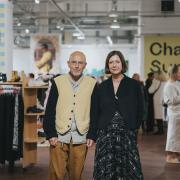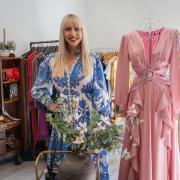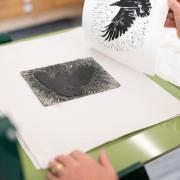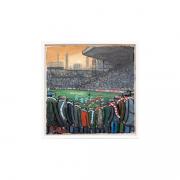Adamley, in Macclesfield, still use ancient processes to print on their silk, which is sought after worldwide, says Kate Houghton

Adamley is possibly one of Cheshire’s best kept secrets. There has been a silk mill on their site in Langley for over 400 years, taking advantage of the special water quality that, when used to wash silk (made in China and sent to the UK) produces a sheen, a soft lustre, that cannot be reproduced by modern methods.
I met with Tro Manoukian, managing director of Adamley, to learn more about this hidden gem.
He tells me: ‘Much of what we do is hand-printing silk for high-end ladies’ and gents’ accessories, which can retail from £100 to…well, the sky’s the limit! Almost all of our clients have seen a massive resurgence in the demand for artisan production in recent years and the label “Made in England” or “Hand printed in England” delivers a promise of quality recognised all over the world.’
Artisan production is the perfect way to describe what happens here at Adamley. The pattern archives stretch back to 1722 and machinery first fitted in Victorian times is still in use. The business simply cannot be wholly mechanised, which means that skill and experience developed over decades are vital elements in the workforce.

The process starts in China, of course, where raw, ivory coloured silk is sourced from three specific regions. While it is washed there, it is the extra washing treatment that takes place in Macclesfield that makes a big difference to the finished product.
‘The silk is washed in water from our own lake,’ Tro tells me. ‘Our specific washing process and the water [filtered for centuries through the limestone hills] gives a unique lustre.
‘Before we start on any project the client decides what print they want on their silk. They can choose something from our archives, we can design something for them ourselves or they can supply their own design.
‘Next, the dyes are mixed by hand. Every dye is made specifically for a single order. A pink print on navy will require a different recipe to a pink on orange, for example.
‘The pattern agreed upon is then engraved onto the silk printing screens, using a wax jet engraver. There is a very intensive process of checking each design for total accuracy.
‘Our print runs can range from just 1m [for a single tie, or scarf , indeed, a single pocket square 45cm x 45cm is not unheard of] to 400m. A design can require up to eight screens being used. If even one screen is a fraction of a millimetre out then the whole run is ruined.’
The skill needed to ensure this level of accuracy is extraordinary and can only come from years of practice. The hand-screen printing is managed by teams of two men. Fascinatingly, their height and weight is important to the process, as they must be balanced across the table as they work – too much weight on one side will affect the pressure. The ‘printer’ is in charge and works with a ‘layer’. They pass a squeegee back and forward between them, pushing the dye into the silk and moving the frame along the table as they go. A table can be 22m long and every sweep of the squeegee must be exactly the same as the last – any variance in shading and it’s all over.
After printing, the fabric is then steamed to ‘cure’ it and set the dyes. Machines first used 200 years ago bash the silk to soften the fibres, giving it the liquid, luscious feel only found in this most premium of products.
I’m quite thrilled that such a fabulous product, sought after by the sartorial cognoscenti of the world (from haute couture designers to their very knowledgeable clients to famous-name tailors) and wonder why the Adamley brand isn’t famous in its own right.
Tro explains: ‘It is a conscious decision to remain a hidden gem. We are in the position of having the luxury of choosing who we want to work with and they do not need or want our brand to have any prominence. I don’t think the British people appreciate the power of the legacy we have here in terms of artisan production. The words ‘Made in England’ carry great weight.’
It is not only the penetration into the global luxury market that Adamley should be congratulated on, but also their extraordinary design archive, stretching back through the centuries and now protected for future generations by being also held on digital databases, with some very secure disaster recovery protocols in place.
Adamley may have a global presence (stealthy though it is) but they have an awareness of their local impact too and donate up to ten per cent of their profits to charity each year, with a hospice in Macclesfield benefitting in 2015.
Adamley is the sort of business its owners, workers and indeed we all can be proud of…made in Cheshire, but global impact.
A study in silk
The photography you see here comes from Paul Worpole, a local professional photographer who heard about Adamley quite by chance and decided to investigate further.
‘It was 2am and I was working and listening to Radio 4. The words ‘silk mill in Macclesfield’ caught my attention. I’ve always been fascinated with the artisan talent in this country. We’re so good at one-off, bespoke design and production and Adamley has been doing this for centuries.
‘I called and arranged to go and learn more. I was stunned by the heritage of the place and the fact that it’s so relatively unknown. These photographs are my own way of celebrating this heritage and the people who are maintaining that today.’



























